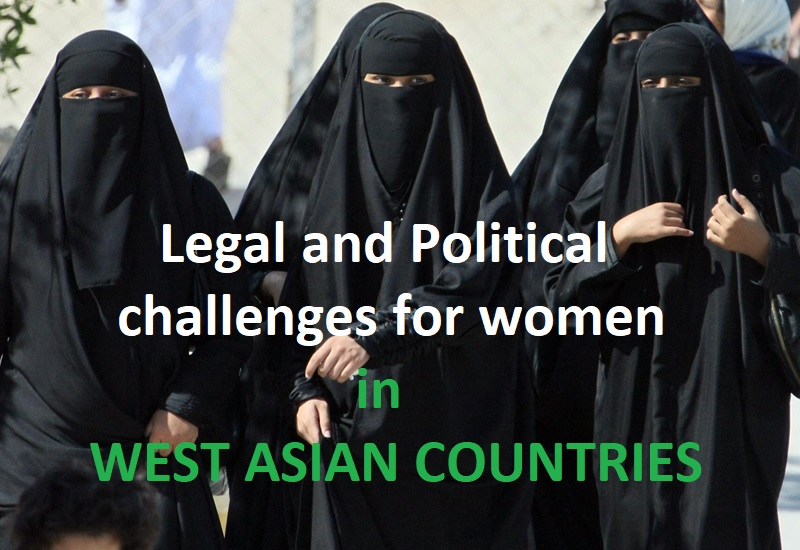A Project On Legal and Political challenges for women in West Asia
In this project we will explore the latest insights on legal and political challenges faced by women in West Asian countries. Dive into important discussions on women’s rights, gender equality, legal barriers, and political obstacles in the region. Click the link to read more
Introduction
Welcome to our exploration into the world of women’s rights, focusing on the unique legal and political challenges that women face in West Asian countries. This region, rich in culture and history, is also a battleground for gender equality, where women are making strides against deeply ingrained legal barriers and political obstacles. In this journey, we’ll delve into the complexities of the situation, highlight some of the significant challenges, and celebrate the victories, however small they might seem. West Asia’s story of women’s rights is not just about struggles; it’s about resilience, bravery, and the tireless fight for equality. Join us as we uncover the layers of these challenges and the hopes that light up the path forward.
The Legal Landscape for Women in West Asian Countries
The quest for gender equality in West Asia confronts a complex matrix of legal barriers that significantly restrict women’s freedoms and rights.
This region, with its diverse cultural and legal systems, presents unique challenges that exacerbate the struggle for women’s empowerment.
Overview of legal barriers faced by women
Legal barriers for women in West Asia are multifaceted and deeply ingrained in the societal and legal frameworks of many countries.
These obstacles often manifest in laws related to marriage, divorce, inheritance, and custody of children.
For instance, in some countries, women do not have the same rights as men to initiate divorce proceedings, and laws governing inheritance significantly
favor male heirs over female ones.
Additionally, women’s ability to travel, work, and even access healthcare can be severely restricted without the consent of a male guardian, curbing their
independence and autonomy.
Specific examples of discriminatory laws
One striking example can be found in the personal status laws that govern family matters.
In some nations, these laws stipulate that a husband can divorce his wife more easily than the reverse.
Furthermore, in matters of inheritance, daughters often receive half the share that sons do, deeply entrenching economic disparities between genders.
Another poignant example is the legal requirement for women to obtain permission from male guardians to engage in basic activities such as traveling
abroad in certain West Asian countries.
These specific laws vividly illustrate how the legal system can directly impact women’s daily lives and their socio-economic status.
Political Obstacles for Women in West Asia
The political sphere in West Asia often mirrors and reinforces the societal norms that limit women’s rights, with patriarchal structures deeply embedded in
the political systems.
This presents significant hurdles for women aiming to participate in political life or advocate for gender equality.
Patriarchal political systems and their impact on women’s rights
The patriarchal nature of political systems in West Asia not only limits the participation of women in politics but also affects the priority given to women’s
rights issues.
Political parties and decision-making bodies often reflect the male-dominated society, leading to policies and laws that overlook or even suppress women’s
rights.
This patriarchal framework ensures that the political agenda is steered away from issues that impact women directly, slowing progress towards gender
equality.
Challenges in political representation for women
Despite some progress in recent years, women in West Asia still face considerable obstacles in achieving political representation.
Electoral systems and party politics do not always support or promote female candidates, and societal norms can discourage women from engaging in
political life.
In some cases, quotas have been introduced to ensure women’s representation in legislative bodies, but these measures often meet resistance and are
sometimes seen as tokenistic rather than substantive progress towards gender parity in politics.
Case studies of women activists in the political arena
The challenges notwithstanding, there are inspiring stories of women who have overcome barriers to make significant impacts in the political arena of
West Asia.
For example, women activists in Lebanon have been at the forefront of protests and movements advocating for political reform and gender equality.
Their persistence has brought international attention to the issues facing Lebanese women and has forced some level of dialog within the political
establishment.
Similarly, in Iran, women have been key players in recent protests, demanding their rights in the face of severe state repression.
These women, and many like them across the region, exemplify the resilience and determination needed to confront and overcome the deeply entrenched
gender biases in both the legal and political domains.
These examples highlight not only the significant hurdles that women face in West Asia but also the persistent struggle and activism that continue to push
the boundaries, challenging the status quo in hopes of achieving greater gender equality and empowerment.
Women’s Rights Activism in West Asia
The quest for gender equality in West Asia is a vibrant tapestry of grassroots movements, activist campaigns, and international solidarity, each playing a
pivotal role in challenging and reshaping the legal and political landscapes that have traditionally marginalized women.
Role of grassroots movements in advocating for gender equality
Grassroots organizations have proven to be the backbone of the feminist movement in West Asia.
Operating at the local level to address the unique challenges women face in their communities.
These movements often start small, focusing on specific issues such as access to education, the right to drive, or the fight against legal provisions that
discriminate against women.
By mobilizing at the community level, these organizations can directly engage with women, offering them a platform to voice their concerns, share their
stories, and demand change.
Through protests, awareness campaigns, and community programs, grassroots movements have become a powerful force for advocating gender equality
and providing the necessary support networks for women to assert their rights.
Success stories of women’s rights campaigns
The success stories of women’s rights campaigns in West Asia are a testament to the resilience and courage of its women.
Notable examples include the lifting of the driving ban for women in Saudi Arabia, a landmark victory resulting from years of campaigning and international
pressure.
Another significant achievement is the amendment of legal provisions that allowed rapists to escape punishment if they married their victims, a law that
has been changed in several countries in the region due to relentless activism and public outcry.
These victories are just the tip of the iceberg, highlighting the potential for change when women unite and fight for their rights.
International support and collaboration
International support and collaboration have played a crucial role in amplifying the voices of women in West Asia.
Global organizations and foreign governments have provided essential resources, training, and international platforms for activists to share their
experiences and gain international visibility.
This external support has not only helped to pressure local governments into reform but has also fostered a sense of global solidarity.
And among women’s rights movements, facilitating the exchange of strategies, ideas, and lessons learned.
The combination of local activism and international support creates a robust mechanism for pushing forward the agenda of gender equality in West Asia.
The Way Forward for Women in West Asia
As women in West Asia continue to fight for their rights and equality, there are several strategies and approaches.
This can further support their efforts and help overcome the entrenched legal and political challenges.
Strategies for overcoming legal and political challenges
To effectively combat legal and political obstacles, a multi-faceted approach is necessary.
This includes continued advocacy for legal reform, utilizing international human rights frameworks to hold governments accountable, and increasing
women’s representation in political and legal institutions.
Strengthening coalitions between different feminist groups, human rights organizations, and progressive political parties can also amplify their collective
voice and influence.
Moreover, leveraging technology and social media can enhance communication, mobilization, and awareness-raising efforts, providing a powerful tool to
challenge stereotypes and promote gender equality on a wider scale.
Importance of education and awareness
Education and awareness are critical components in the fight for women’s rights in West Asia.
By educating both women and men about gender equality, human rights, and the benefits of an equitable society, ingrained biases and discriminatory
practices can be challenged and changed.
Educational initiatives should be aimed at all age groups, starting from early childhood to ensure a foundation of equality and respect.
Awareness campaigns also play a crucial role in debunking myths, highlighting the reality of women’s experiences, and showcasing the advantages of a
more gender-inclusive society.
Recommendations for policymakers and global organizations
To further empower women in West Asia, policymakers and global organizations must prioritize gender equality in their agendas.
This includes implementing and enforcing laws that protect women’s rights, removing legal barriers that hinder women’s participation in public and
economic life, and ensuring women’s voices are heard in decision-making processes. International organizations can support these efforts by providing
resources, sharing best practices, and applying pressure on governments to fulfill their international human rights obligations. Additionally, increasing
funding for women’s rights organizations and initiatives can enable them to continue their vital work on the ground. Lastly, a collaborative approach that
engages men as allies in the fight for gender equality is essential for creating lasting change.
Conclusion
In wrapping up, the journey toward gender equality and women’s empowerment in West Asian countries is undoubtedly paved with significant legal and
political challenges.
From disparities in family law to restrictions in the political arena, women in these regions face barriers that limit their opportunities for development and
participation on an equal footing with men.
Despite these hurdles, there’s an undeniable wave of resilience and activism among women, bravely advocating for their rights and pushing for reforms.
– Persistence in advocacy and grassroots movements is key to driving change.
– International support and attention can amplify the voices of those fighting for equality.
The road ahead is long, but with continued effort, solidarity, and global support, the aspirations for gender equality and women’s rights in West Asia can
become a closer reality.
Let’s stand in support of these brave women and keep the conversation going.





0 Comments